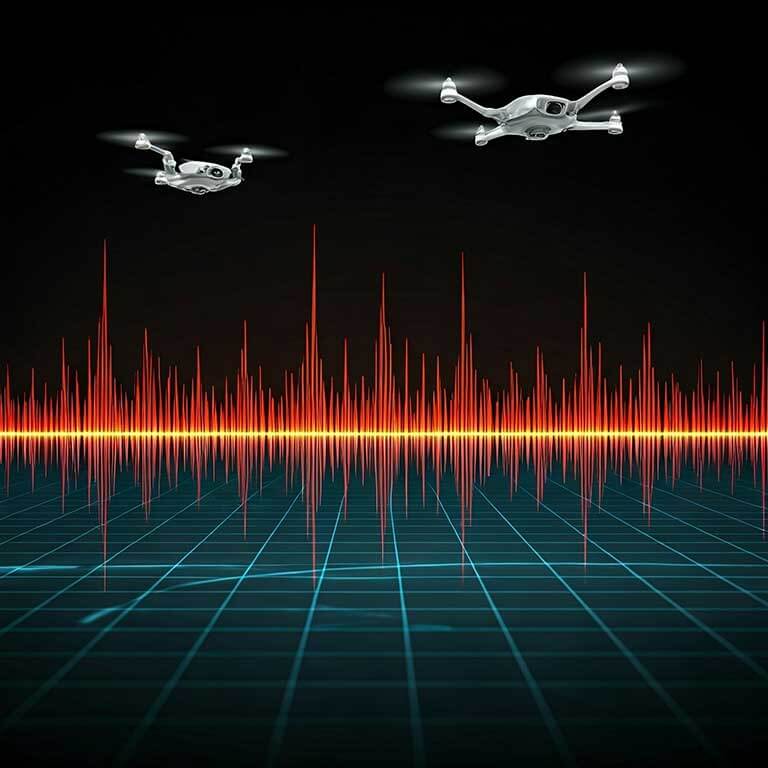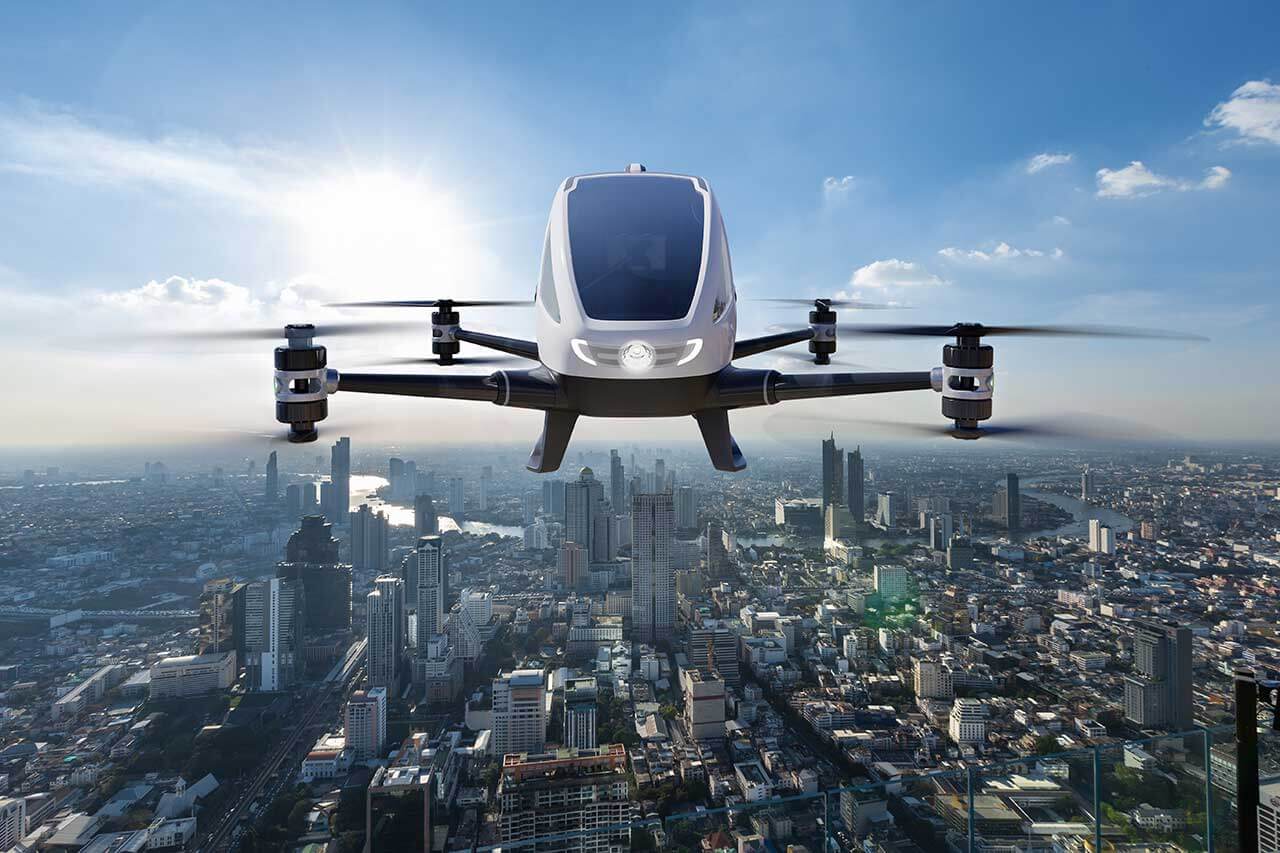The skies continue to change. Once the exclusive domain of crewed aircraft, U.S. airspace is increasingly filled with new entrants. Uncrewed aircraft systems (UAS) (or “drones”) already assist law enforcement, support search and rescue, deliver critical medical supplies and help to gather news. More complex operations, including those that occur beyond visual line of sight (BVLOS), continue to accelerate. The next wave will involve larger Advanced Air Mobility (AAM) vehicles, such as electric vertical takeoff and landing (eVTOLs or “air taxis”).
As the airspace evolves, so too must the regulatory landscape, especially the rules governing the radio frequency (RF) spectrum that underpins command and control (C2) systems. This article, based on a recent Federal Communications Bar Association (FCBA) panel, explores the latest regulatory updates from the Federal Communications Commission (FCC) which aim to bolster the level of safe and reliable digital infrastructure required for drones and air taxis.
The Surge in Emerging Aviation Operations
As of April 2025, there are over 1 million drones registered with the Federal Aviation Administration (FAA) in the United States. By 2030, that number is expected to more than triple to 6.5 million. A broad range of public and private applications, from agriculture and infrastructure inspection to emergency response and package delivery are driving this explosive growth.
AAM encompasses a broad spectrum of new aviation technologies, including passenger air taxis, cargo drones and regional air mobility services. These vehicles are often electric, capable of vertical takeoff and landing, and may eventually operate autonomously.
Recognizing the need for highly reliable RF communications for flight control, the FCC has taken decisive steps to modernize spectrum regulations to support this burgeoning sector.

FCC’s August 2024 Report and Order: A Milestone for UAS Spectrum Access
In August 2024, the FCC approved a pivotal Report and Order (FCC Order FCC-24-91, Docket No. 22-323) adopting initial rules that will enable UAS operators to access dedicated spectrum for control operations in the 5030–5091 MHz band. This move is designed to support what the FCC terms “Control and Non-Payload Communications” (CNPC) transmissions between the uncrewed aircraft (UA) and ground stations essential for the safety and regularity of flight.
What Spectrum Drones Have Been Using
Most drones in the U.S. have relied on unlicensed spectrum, or the same frequencies used by Wi-Fi routers and other consumer devices, for their C2 communication. This includes the 2.4 GHz and 5.8 GHz ISM (Industrial, Scientific, and Medical) bands, which are widely available but unprotected and therefore susceptible to interference from other users.
In addition to unlicensed bands, some commercial drones and advanced operators have used licensed commercial wireless networks (such as LTE/4G/5G) where permitted, especially for non-safety-critical payload data or in areas where FCC rules do not restrict airborne use of those bands. However, the use of commercial cellular spectrum for C2 has been limited by regulatory restrictions and concerns about interference with terrestrial services.
Prior to the 2024 FCC rule on the 5030-5091 MHz band, the UAS industry lacked exclusive, protected, broadly available spectrum for UAS control links, which raised safety and reliability concerns as drone operations expanded.
Why Reliable and Dedicated Spectrum Matters
UAS control links require a level of reliability that far exceeds that of everyday consumer wireless communications. While a dropped phone call may be inconvenient, a lost connection with a drone in controlled airspace could have severe consequences.
Industry leaders and technical experts agree that existing spectrum allocations are insufficient for the scale and safety requirements of modern UAS operations. The aerospace community is highly safety-conscious. Absent significant upgrades and technical changes, the anticipated volume of drone flights would overwhelm legacy systems designed for crewed aircraft.
Various stakeholders are working on how best to solve these problems, including:
- Wireless Industry: Commercial wireless networks offer robust, secure and nationwide coverage, but the drone industry will require a mix of licensed and unlicensed spectrum to meet all operational needs.
- Manufacturers and Standards Bodies: Organizations like the Radio Technical Commission for Aeronautics (RTCA) and Aeronautical Radio, Incorporated (ARINC) have developed technical standards (e.g., the 362 series) to ensure interoperability and safety.
- Aviation Companies: Firms like Boeing and Wisk are preparing for high-density operations and advocating for dynamic frequency management and streamlined licensing.
Once implemented, the new FCC rules will allow operators to obtain direct frequency assignments in the 5040-5050 MHz frequency range of the 5030–5091 MHz band, managed through dynamic frequency management systems (DFMS). These systems provide temporary real-time frequency assignments to support UAS control link communications, particularly in safety-critical situations. Operators will be able to obtain Non-Networked Access (NNA) to the designated spectrum—direct, non-networked communications between ground stations and drones within radio line of sight.
Interim Access Mechanism
To bridge the gap before the full implementation of DFMS, the FCC has introduced an “interim access mechanism” for NNA operations. Once implemented, this process will allow operators to request temporary access to the spectrum, subject to FAA deconfliction and FCC registration, to ensure that safety and coordination remain paramount. During the interim access phase, operators will have access to a 20 megahertz swath of the band, at 5040-5060 MHz, rather than the 10 megahertz that will be available once the DFMS regime has been stood up.
A Staggered Approach: Phasing in Spectrum Access
Rather than implementing sweeping changes all at once, the FCC has opted for a phased, staggered approach to spectrum access for UAS. This reflects the complexity of integrating new aviation technologies into the national airspace system (NAS) and the necessity of balancing the interests of diverse stakeholders, from regulators and industry to public safety agencies and commercial operators. At the same time, the FCC has not necessarily moved as quickly as it could in making these spectrum resources available.
Timeline and Regulatory Evolution
The regulatory journey for UAS spectrum access has been marked by incremental progress and careful deliberation. It all began in 2012 when the World Radiocommunication Conference (WRC) allocated the 5030 MHz band for aeronautical mobile route services, with the intention of supporting UAS C2. Since then, the domestic UAS industry has seen the following developments.
- 2017: The FCC mirrored the WRC’s 5030–5091 MHz band allocation domestically, but did not adopt any service or licensing rules to allow the band to be operationalized for drone C2.
- 2018: Industry advocacy and congressional mandates accelerated the process, with the Aerospace Industries Association petitioning for formal rulemaking and Congress directing the FCC, FAA and NTIA (National Telecommunications and Information Administration) to evaluate UAS spectrum needs.
- 2021–2023: Subsequent years saw the FCC gathering public input, updating the record and issuing a Notice of Proposed Rulemaking in 2023. It proposed dividing the band between NNA and Network Supported Services (NSS – future networked operations enabling broader, more complex use cases), with dynamic frequency management envisioned for efficient spectrum assignment.
- 2024: The August 2024 Report and Order marked a significant milestone by establishing initial rules for limited NNA access, while deferring more complex networked operations and a final band plan to future proceedings as the agency gains experience and stakeholder input.
Following release of the Report and Order, the item was published in the Federal Register, and new regulations that require information collection are working their way through the Office of Management and Budget review process. And as of the time of this publication, the FCC’s Wireless Telecommunications Bureau—the division of the agency charged with implementing the interim access mechanism for short-term access to the spectrum—has not yet released any public information on establishing that process.

Technical Standards and Safety Considerations
The FCC’s rules are closely aligned with technical standards developed in collaboration with the FAA and industry groups. These standards focus on long-range, high-reliability communications, especially for drones operating in controlled airspace alongside crewed aircraft.
The Role of Dynamic Frequency Management
The DFMS regime for the 5030 MHz band is modeled after the FCC’s Citizens Broadband Radio Service (CBRS) framework in the 3.5 GHz band. These systems dynamically assign frequencies to operators, manage interference and ensure regulatory compliance. Although there have been implementation challenges in standing up CBRS, the FCC concluded in the 2024 Report and Order that “a DFMS approach can be feasibly implemented drawing on these tested technologies and methods.”
Equipment Certification
All UAS equipment intended for use in the 5030–5091 MHz band must be certified by the FCC for compliance with new technical rules. This ensures that only qualified devices access this safety-critical spectrum.
The FCC coordinates with the FAA to ensure that equipment not only meets spectrum and interference requirements but also aligns with aviation safety standards. The FAA has adopted minimum performance standards for UAS radio equipment in this band, and equipment must conform to these standards as part of the overall certification and operational approval process.
These minimum performance standards are located in Technical Standard Order (TSO) C213a, Unmanned Aircraft Systems Control and Non-Payload Communications Terrestrial Link System Radios. TSO-C213a adopts aspects of the RTCA DO-362A standard as the minimum performance standard for CNPC Link Systems designed for operations within any spectrum in the 5030–5091 MHz band
Addressing Technical and Operational Challenges
The FCC’s work is far from complete. As discussed above, the agency intends to conduct additional proceedings to develop a final band plan for the 5030 MHz band that will accommodate both NSS and NNA operations. In addition, the UAS industry faces other technical and operational hurdles, including:
- Multi-Link Communications: Safety standards require multiple redundant communications links for critical UAS operations. These must combine dedicated spectrum, commercial wireless and satellite connections as needed.
- Detect and Avoid (DAA): Low-altitude radar and surveillance infrastructure are essential for situational awareness, collision avoidance and counter-UAS capabilities. The FCC and FAA are exploring expanded use of certain bands to support these functions.
- Counter-UAS Technologies: As drones proliferate, so do concerns about unauthorized or malicious operations. Counter-UAS systems focus on detecting, identifying, and, where legally permissible, disabling rogue drones. However, intentional jamming of communications remains prohibited, with exceptions primarily for federal agencies.
Expanding the Spectrum Toolbox
While the 5030–5091 MHz band is a cornerstone for UAS C2, other spectrum bands are also under consideration:
- 450 MHz Band: The FCC is considering updating its rules for the band consistent with the waiver granted to AURA Networks to support long-range links and flexible use.
- 24 GHz Band: Potentially expanded for radar and detection operations, enhancing situational awareness and public safety.
- Higher Frequency Bands and Flexible Use Spectrum: Millimeter wave bands (above 26 GHz) offer high capacity and low latency, suitable for payload data and non-critical communications over short ranges. And as noted above, flexible use spectrum (terrestrial spectrum that is not prescribed for a specific use), which includes both millimeter wave spectrum and other frequency bands used by the wireless industry, is of great interest given that commercial mobile networks are already deployed nationwide. In the Notice of Proposed Rulemaking that preceded the 2024 Report and Order on the 5030 MHz band, the FCC sought public input on the suitability of flexible use spectrum for the drone industry.
Looking Ahead: Shaping The Future of Spectrum
The modernization of spectrum law is a critical enabler for the next generation of aviation. To prepare for when drones and air taxis become an integral part of daily life, the FCC must still do the following:
- Final Band Plan: Allocate additional portions of the 5030–5091 MHz band for both networked and non-networked operations.
- Multi-Stakeholder Processes: Engage industry, government, and technical experts to refine dynamic frequency management and licensing procedures.
- Interference Protection: Ensure that the final band plan enables safe coexistence with adjacent and incumbent in-band spectrum users.
- Expand UAS Spectrum Options: Conduct additional proceedings to ensure that UAS have adequate spectrum available to meet the industry’s C2 and payload needs.
For industry stakeholders and policymakers, several clear imperatives remain. Ongoing rulemaking and multi-stakeholder collaboration are both vital for shaping a regulatory environment that keeps pace with technological advances and operational needs.
The future of UAS and air taxis will depend on embracing flexibility – a mix of dedicated, commercial and unlicensed spectrum – to support the full range of use cases, from routine package delivery to passenger transport in urban environments.
Above all, safety must remain the priority. Redundant communications, robust detection and counter-UAS capabilities will form the backbone of public trust and operational reliability.
Finally, as U.S. spectrum policy both influences and is shaped by international standards and best practices, a global perspective will be crucial to ensure harmonized, scalable solutions that enable the promise of connected skies.
As the skies continue to evolve, spectrum law will be the invisible infrastructure supporting a safer, smarter and more connected future for drones and air taxis.
*Sara Baxenberg is a partner at Wiley Rein, advising on regulatory, litigation, transactional, and compliance matters in telecommunications, uncrewed aircraft systems, and emerging technologies. She represents clients before agencies like the FCC and FAA, and has been recognized as a “Rising Star” by Law360 and Super Lawyers. Baxenberg holds a J.D. from Harvard Law School.
By: Dawn Zoldi and Sara Baxenberg*

